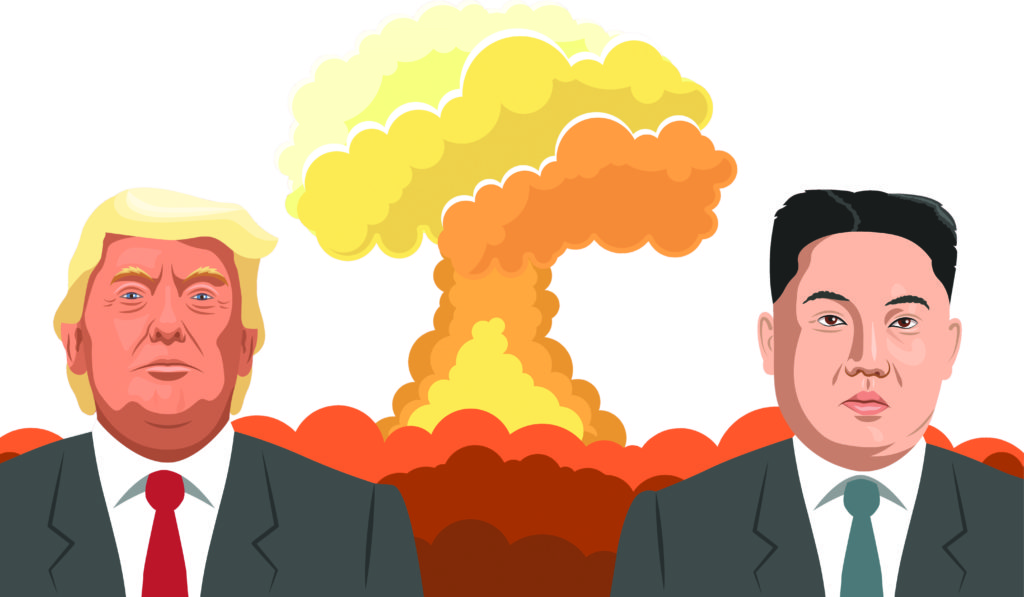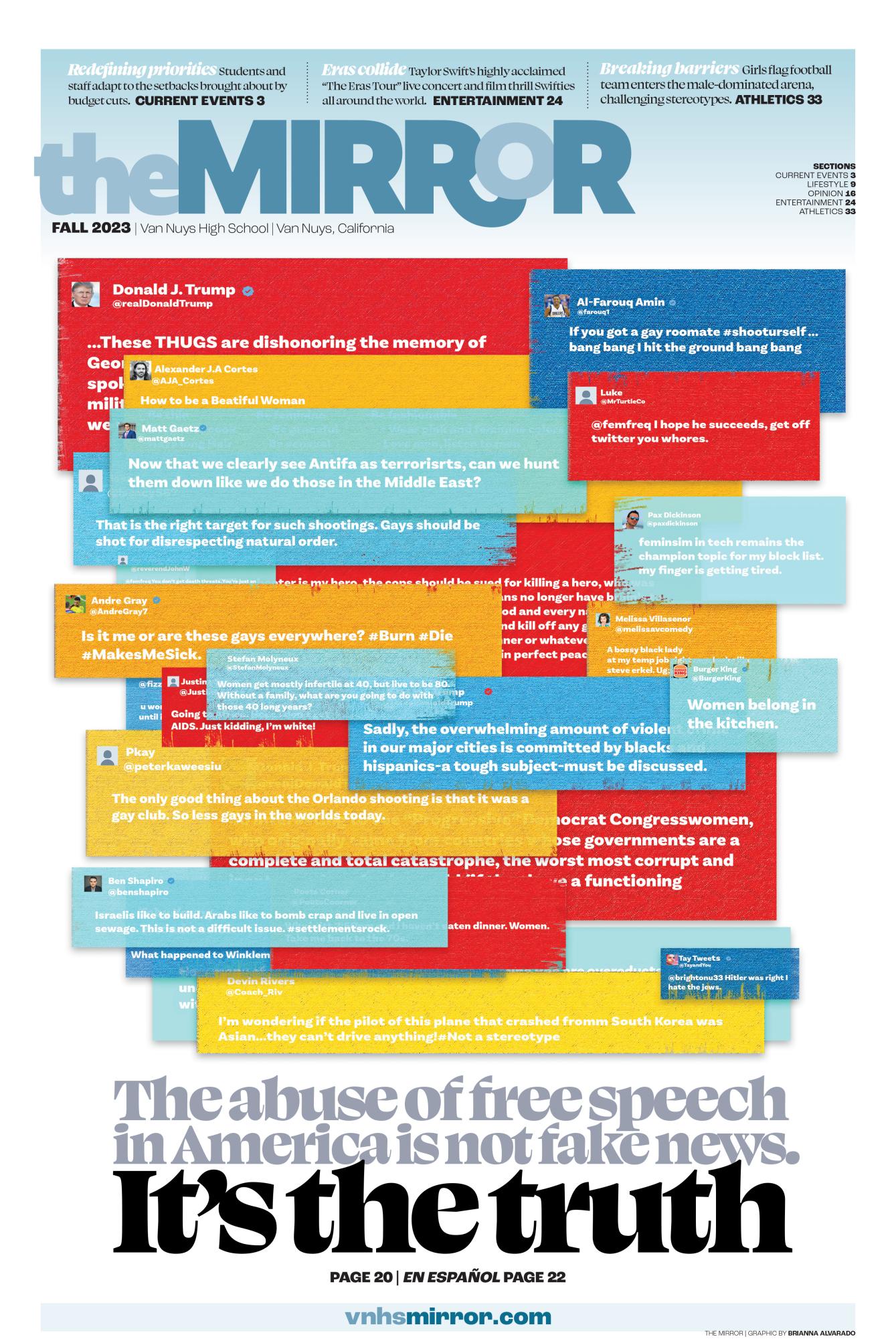By Chandler Beon
The Mirror
Web-Layout Editor
“You don’t know. It’s the unpredictable nature of the North Korean regime.”
FEATURE
Ground Zero
September 27, 2017
FEATURE: Could Los Angeles end up as a target in the simmering nuclear standoff between Donald Trump and Kim Jong Un?
The United States of America is on the brink of a nuclear war.
Considering North Korea’s rapidly developing nuclear and missile projects and the growing political rhetoric coming from politicians the U.S., it’s no surprise that a nuclear conflict is a possible outcome of the conflict that has lasted for over six decades.
Volatile, unpredictable leaders who are unwilling to yield on both sides of the conflict make a nuclear scenario seem more and more within the realm of possibilities.
With his recent tweets against the Democratic People’s Republic of Korea, President Donald Trump continues to fuel the fire. Criticizing Kim Jong Un’s dictatorship for continuing to fire test missiles and ending with a denouncing “Bad!,” President Trump’s words may as well bring the United States into a war sooner rather than later.
What’s concerning isn’t the fact that threats of war are being thrown around, but the fact that North Korea might be able to create an intercontinental ballistic missile which could reach the U.S. mainland within the next decade, according to military analysts.
If they are successful and tensions continue to rise, then there’s a high possibility one of their targets could be a thriving city on the southern coast of California: Los Angeles.
History of the Conflict
The head-clashing started with the Cold War in the 1950s. The Korean War caused a split between South Korea, supported by the United States, and North Korea, aided by the Soviet Union (U.S.S.R.). Though it may have seemed like a war between two republics of a country, it was noted as a war for and against Communism.
The end of the war was marked by the Korean Armistice Agreement, which set the two adversary’s current borders. The armistice still stands to this day. Even so, the bitterness remains.
The United States closely supported South Korea while the U.S.S.R. and China supported North Korea economically and militarily.
Increasingly isolated, North Korea turned to China and embarked on a nuclear program in a race to become a serious military power with the late dictator, Kim Jong Il, leading the efforts.
The country tested its first nuclear bomb on October 9, 2006. Still in its early stages, the nuclear development project proved the regime’s resolve to advance their nuclear arsenal despite an attempt at intervention from foreign countries.
The death of Kim Jong Il marked the beginning of a new era for the North Korean nuclear and missile development project. His son and successor, Kim Jong Un, took the torch and made massive improvements to the project, pumping in money and resources.
Even though he has been dictator for only six years, Kim Jong Un has already tested more than twenty times as many missiles than his father did.
The Nuclear Race Begins
The holy grail for the North Koreans is developing a missile that could deliver a warhead to North America.
As of yet, the North Korean government has still not successfully been able to create an intercontinental ballistic missile (ICBM), let alone one that can reach even halfway across the Pacific Ocean.
The furthest they have been able to launch a test rocket so far has been about 400 miles.
This sigh of relief is only temporary—most experts say it won’t be long until North Korea has the technology capable to launch a long-range missile.
In fact, the North Koreans successfully launched their own satellite into earth orbit early last year, joining space-capable nations like the U.S., Russia, China, India, and Japan.
Currently, the U.S. maintains the world’s largest nuclear arsenal by far and is the only nation ever to deploy nuclear weapons—to defeat Japan in World War II.
However, as soon as Kim Jong Un gets his hands on a tested and functioning ICBM, the difficulty of the situation increases tenfold.
Not only would North Korea pose a greater direct threat to the U.S., but the two countries would be at a nuclear standoff.
Such a standoff might make the U.S. more reluctant to send military aid if North Korea were to attack one of their neighboring countries like South Korea or Japan. North Korea will have the capability to back up their threats with action.
If the Pyongyang government ever decides to launch an attack on the United States, one of their primary choices would be to launch a nuclear missile to Los Angeles, one of the cities with the largest Korean population outside of Korea and the second-largest city in the U.S.
Its proximity to North Korea and the spread-out population would make it ideal for a preemptive attack.
Other West Coast cities, such as San Francisco, Seattle and Anchorage, Alaska may be targeted as well for their large populations and close proximity to North Korea.
This scenario could be entirely avoided if the United States takes action before North Korea manages to create the missile.
Potential Conflict Resolutions
The U.S. has tried to convince the Chinese to tighten imports into North Korea with no significant results.
Currently, China has the most leverage on the nuclear development program because they supply 85% of all imports to North Korea. Tightening the import flow would limit resources dedicated to building missiles and slow down their development.
China is concerned about North Korea constantly testing their missiles in the Korean Peninsula as well and is taking precautions with what they say and do. Just like South Korea and Japan, the last thing they need is a nuclear missile headed towards their country with less than 45 seconds to respond before impact.
President Trump has agreed to work with China as long as they are cooperative with the import restrictions. He recognizes China’s hesitancy, announcing that the United States will take further action on its own—with or without China’s help.
Another tactic for the United States would be to partner with the leaders of South Korea and Japan to work to discourage North Korea from testing any more missiles.
With the recent election of a new South Korean president, Moon Jae In, the Trump Administration finally has a reliable partner to communicate with in South Korea—along with Japan’s Prime Minister Shinzo Abe—in an effort to bring them into negotiations with Kim Jong Un.
If peaceful solutions fail to work, then the next best thing would be to defend against any incoming missiles. The United States has the Ground-based Midcourse Defense System, better known as the GMD, deployed across the West Coast, tasked with intercepting and shooting down any missiles coming from over the Pacific Ocean.
On the down side, the GMD is only effective against a handful of missiles at one time. If a barrage of missiles were to head towards the United States, there’s no guarantee that all missiles would be intercepted. The reliability of the system is also questionable.
Will It Actually Happen?
Despite the flurry of action, the standoff continues. Both countries have their big red button at the ready, and it doesn’t take much to provoke one another to the point where one side finally decides to press it.
Kim Jong Un’s regular missile tests don’t help either. In the case of North Korea developing ICBMs, Kim Jong Un’s willingness to target Los Angeles—regardless of his passion for Hollywood movies and basketball—shows how headstrong he is about aggressively antagonizing and openly threatening the United States, making the problem even worse.
Waiting too long to act will inevitably result in more conflicts. North Korea will create an ICBM capable of reaching the mainland, the United States might be reluctant to do anything about it—or, Trump may act rashly and provokingly if cooler heads fail to prevail—and China might not have the same grasp on North Korea as it does right now. Consider North Korea’s recent outburst in a state-media news article condemning China’s as gradually shifting towards allying with the U.S.
“You don’t know,” said History Department Chairman Mr. Robert Crosby. “It’s the unpredictable nature of the North Korean regime.”
“As long as the Chinese government stays as it is, it will act as a restraining force to North Korea because it sees no upside to war. China will restrain North Korea to the level they want them to be, which won’t be the same that the United States wants. We’ll have to hope that China makes the right decision.”
At the end of the day, the fate of the simmering conflict depends on world leaders. Their actions will ultimately affect whether peace will be maintained or whether citizens somewhere will be alerted about a North Korean nuclear missile heading their way.


